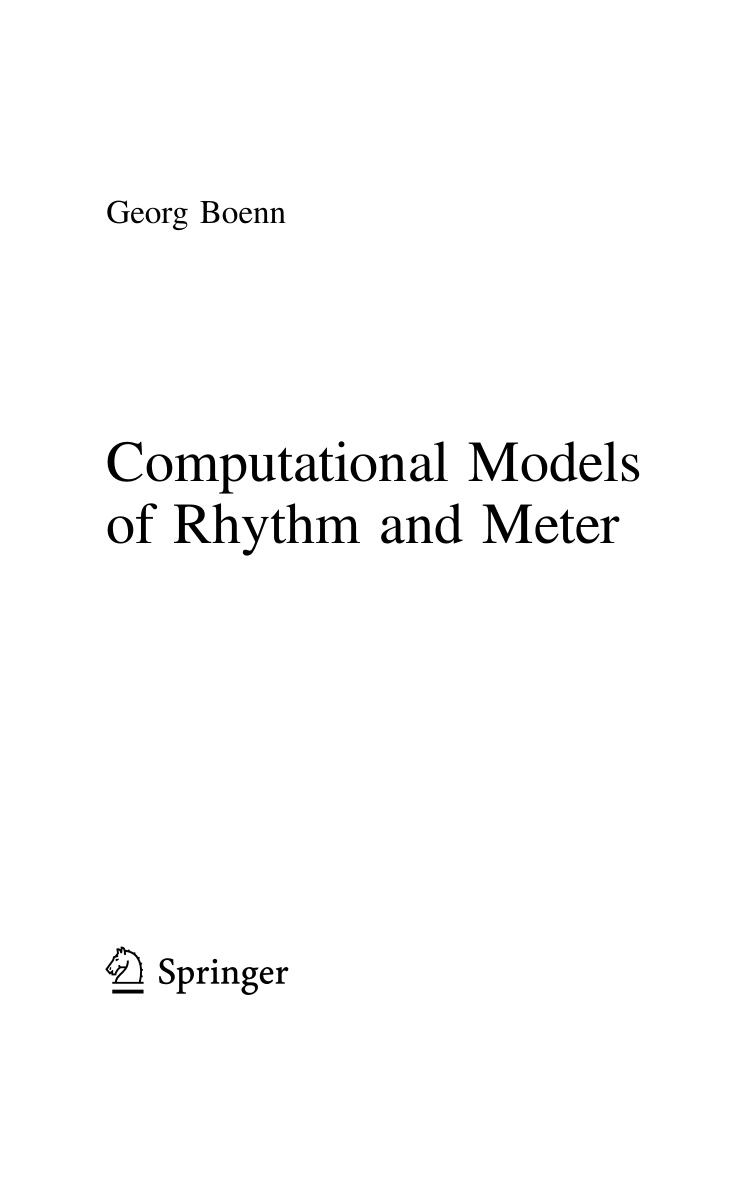Computational Models of Rhythm and Meter by Georg Boenn

Author:Georg Boenn
Language: eng
Format: epub, pdf
Publisher: Springer International Publishing, Cham
We have seen that it is possible to use the Farey sequence as a form of representation of rhythms in Western notation. We will show in Chap. 9 that it can also be used in order to notate onsets recorded from music performances. The method uses Farey sequences to form grid points for rhythm quantisation; the outcome of the quantisation process is then a sub-set of some Farey Sequence . We showed already in Boenn (2007) that Farey sequences can represent rhythms of many diverse styles from different historical and cultural contexts, because of their scalability and self-similarity and because appropriate filters can be found. Results obtained by Desain and Honing (2003) and Papadelis and Papanikolaou (2004) suggest that human listeners categorise performed rhythms in such a way that classes of short rhythmic patterns are formed in the vicinity of relatively small integer ratios. Filtered Farey Sequences are capable of representing such categories.
Graham et al. (1994) have shown that the Stern-Brocot tree can serve to approximate decimal fractions by integer fractions, with arbitrary precision. See also (Martelli et al. 2005, p. 675) for a Python algorithm that approximates floating point numbers into Farey fractions. One of the main advantages of the Farey sequence is that it is scalable to different musical and cognitive timescales and does not rely on context-related manifestations of meter and bar. However, metrical hierarchies on any level can be modelled easily by using filtered Farey sequences.
Musically Relevant Structure of the Farey Sequence
Figure 7.3 shows a plot of that correlates the position of the ratios a / b in the interval with the unit fraction 1 / b built from their corresponding denominators. The unit fractions represent the metrical subdivision by b of the reference duration 1.
Fig. 7.3Correlation of and 1 / b in the interval
Download
Computational Models of Rhythm and Meter by Georg Boenn.pdf
This site does not store any files on its server. We only index and link to content provided by other sites. Please contact the content providers to delete copyright contents if any and email us, we'll remove relevant links or contents immediately.
Algorithms of the Intelligent Web by Haralambos Marmanis;Dmitry Babenko(8517)
Test-Driven Development with Java by Alan Mellor(7343)
Data Augmentation with Python by Duc Haba(7244)
Principles of Data Fabric by Sonia Mezzetta(6989)
Learn Blender Simulations the Right Way by Stephen Pearson(6923)
Microservices with Spring Boot 3 and Spring Cloud by Magnus Larsson(6754)
RPA Solution Architect's Handbook by Sachin Sahgal(6161)
Hadoop in Practice by Alex Holmes(6028)
Jquery UI in Action : Master the concepts Of Jquery UI: A Step By Step Approach by ANMOL GOYAL(5868)
The Infinite Retina by Robert Scoble Irena Cronin(5860)
Big Data Analysis with Python by Ivan Marin(5689)
Life 3.0: Being Human in the Age of Artificial Intelligence by Tegmark Max(5396)
Pretrain Vision and Large Language Models in Python by Emily Webber(4649)
Infrastructure as Code for Beginners by Russ McKendrick(4432)
WordPress Plugin Development Cookbook by Yannick Lefebvre(4163)
Functional Programming in JavaScript by Mantyla Dan(4119)
The Age of Surveillance Capitalism by Shoshana Zuboff(4108)
Embracing Microservices Design by Ovais Mehboob Ahmed Khan Nabil Siddiqui and Timothy Oleson(3954)
Applied Machine Learning for Healthcare and Life Sciences Using AWS by Ujjwal Ratan(3925)
